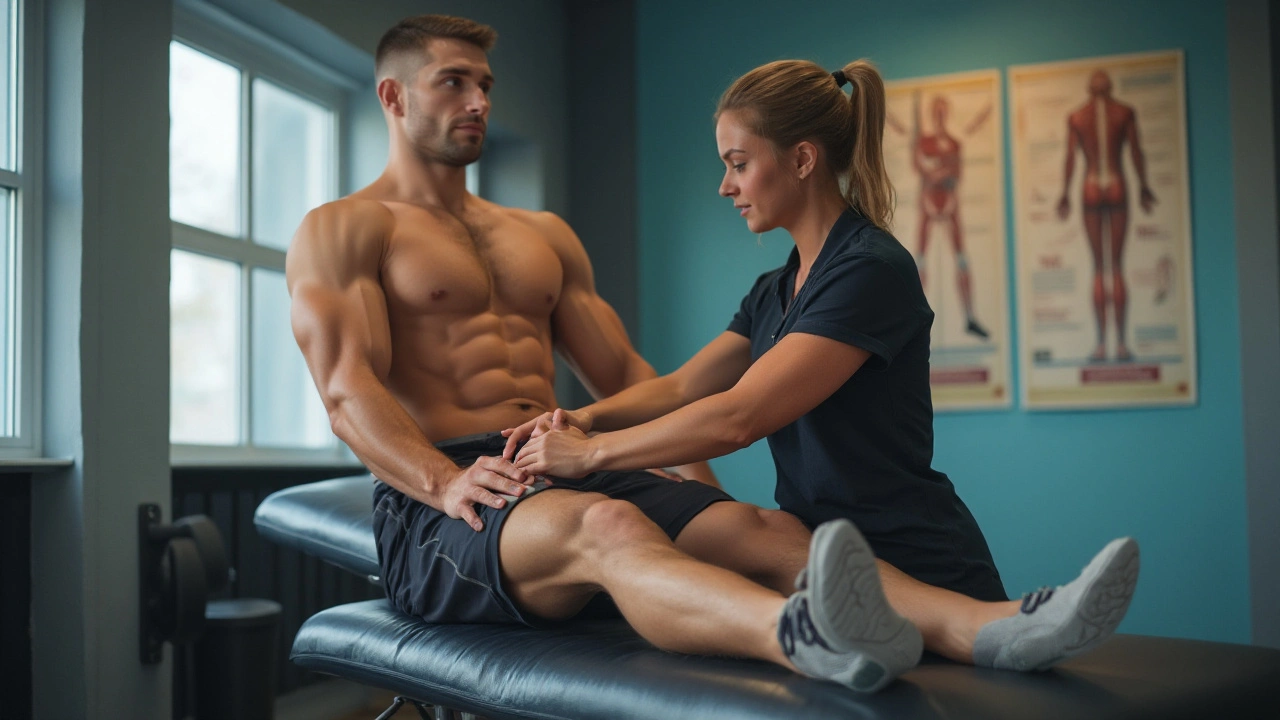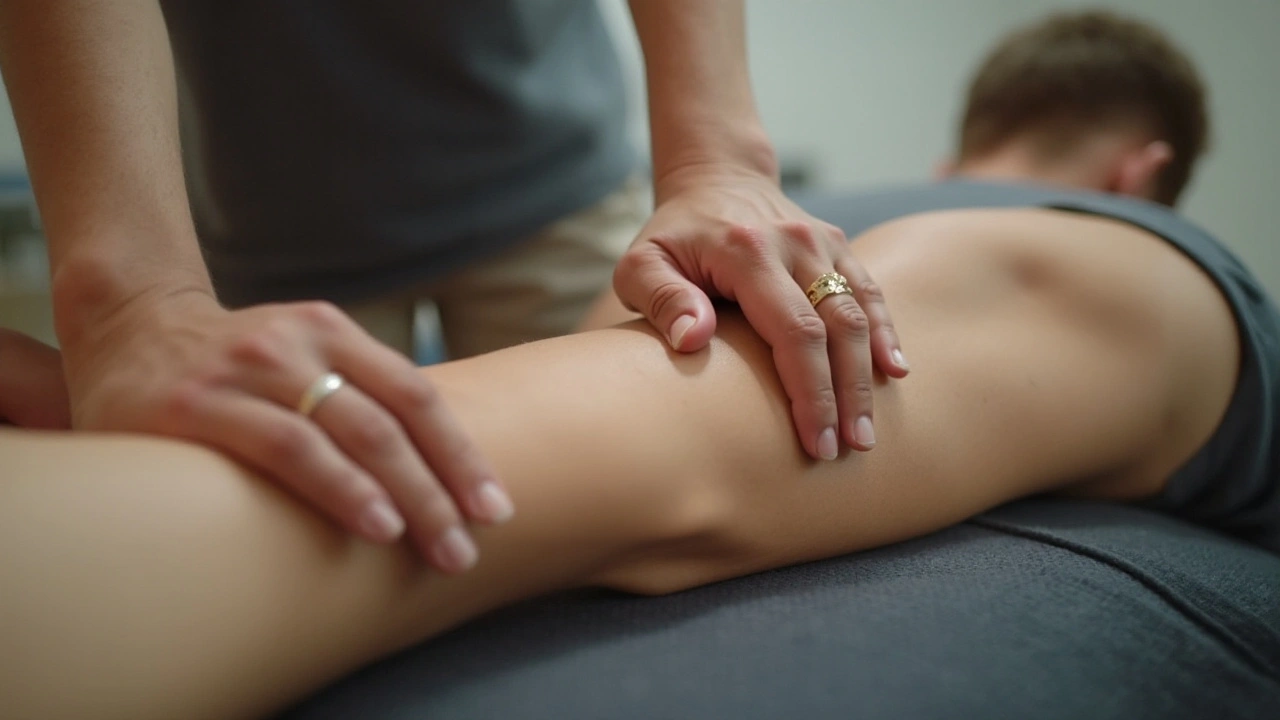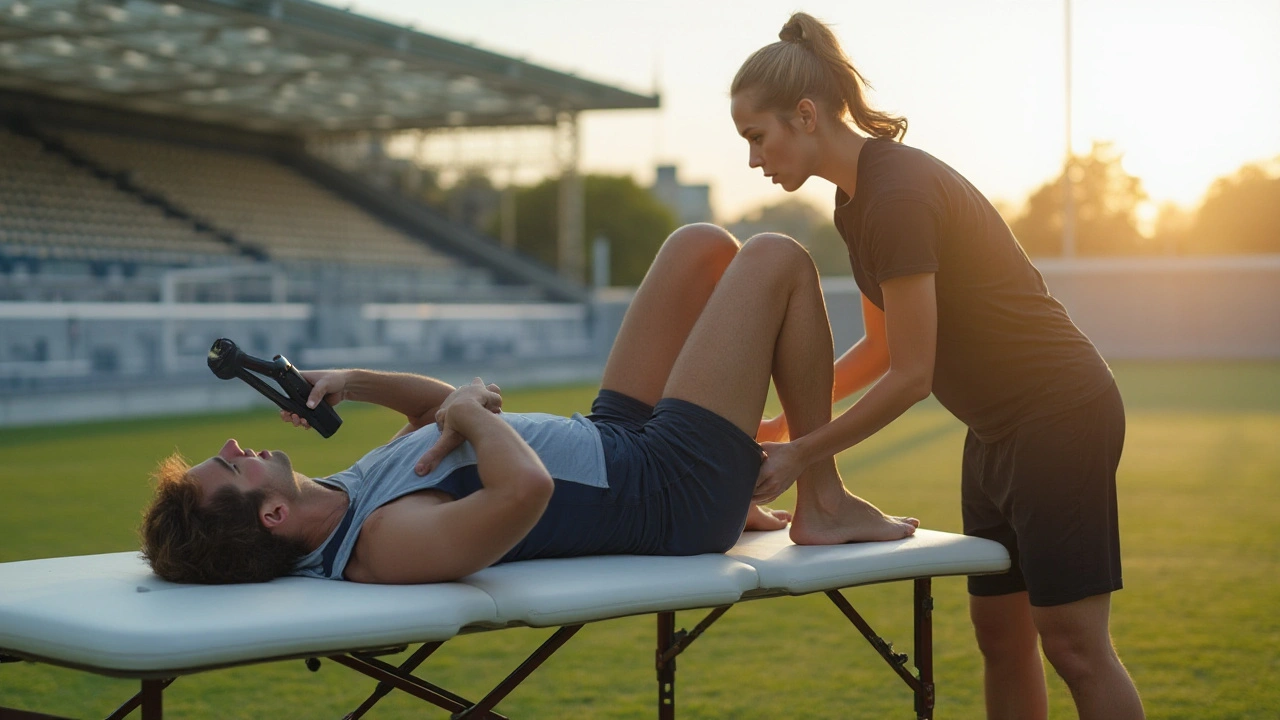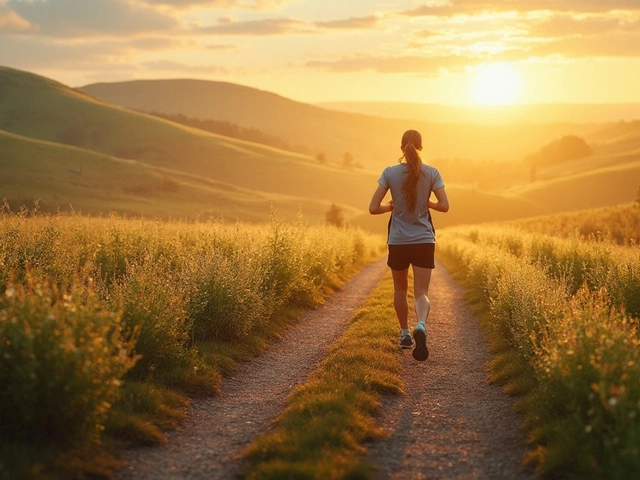
For athletes aiming to hit their peak performance, sports massage is more than just a luxury—it's a necessity. This hands-on treatment focuses on muscles relevant to athletic performance, aiming to enhance endurance, reduce the chance of injury, and speed up recovery times.
Whether you're a seasoned athlete or just hitting the gym regularly, understanding the value of sports massage can make a world of difference in your routine. From boosting flexibility to improving circulation, the right techniques can elevate your game. Dive into the following sections to discover everything you need to know about making sports massage a vital part of your training regimen.
- Introduction to Sports Massage
- Benefits for Athletes
- Techniques and Methods
- When to Get a Sports Massage
- Common Myths Debunked
- Tips for Finding a Good Therapist
Introduction to Sports Massage
Think about those moments when you push your body to its limits, chasing personal records and milestones. It's in these times that sports massage shows its true value. Aimed specifically at athletes and fitness enthusiasts, sports massage involves manipulating the muscles and other soft tissues to improve overall function and enhance recovery. This isn’t just about feeling good, it’s a scientific approach to maintaining peak athletic performance. According to the American Massage Therapy Association, regular sports massages can significantly decrease the likelihood of injury while also shortening recovery time between intense workouts or competitions.
One of the standout benefits of sports massage is how it enhances blood flow. Improved circulation means that muscles receive more oxygen and essential nutrients, which helps them perform better and recover faster. Scientifically, better oxygenation and nutrient delivery help in reducing muscle fatigue. Dr. Tiffany Field of the Touch Research Institute found that even a brief 20-minute massage can significantly lower muscle soreness and improve range of motion.
Another compelling aspect is the focus on flexibility. By regularly receiving a sports massage, athletes can improve their flexibility, making them less susceptible to injuries like sprains and strains. Often, tight muscles are a precursor to injuries. Working through those knots and tight spots, massage helps lengthen muscles and restore balance to the musculoskeletal system.
“A single sports massage can reduce muscle stiffness and increase flexibility, making it very beneficial for people participating in sport and exercise,” says Dr. Mark Tarnopolsky from McMaster University’s Department of Pediatrics and Medicine.
Sports massage also plays a crucial role in stress reduction. Whether it’s pre-competition anxiety or post-training stress, effective massage techniques can soothe both the body and the mind. That's right—it's not just about physical benefits. Reducing mental stress through massage can have a positive impact on focus and performance, turning you into a well-rounded athlete, mentally and physically prepared for your next feat.
This massage style is quite versatile, with distinct techniques tailored to specific needs. Techniques like deep-tissue massage, trigger-point therapy, and myofascial release are frequently incorporated. Each of these focuses on different issues, such as breaking down scar tissue, releasing knots known as trigger points, or stretching the fascia surrounding the muscles to improve movement. You might feel sore immediately afterward, but the benefits you’ll see in the following days make it worth every wince.
While athletes at the elite level often have a team of therapists, this is accessible to everyone. Whether you’re prepping for your first marathon or improving daily workouts, sports massage fits seamlessly into any training regimen. Finding a skilled massage therapist can make a big difference. Look for one with specific training and experience in sports massage, so you get the full array of benefits. Incorporating it into your routine will not only make you feel better but could also give you that extra edge in performance.
Benefits for Athletes
Athletes have long sought out methods to improve their performance and reduce injury risks. Enter sports massage, an effective tool that brings a host of advantages. One of the biggest benefits is its ability to speed up muscle recovery. After a strenuous workout, muscles are often tight and require more time to bounce back. Sports massage helps relax those muscle tissues, which can ease soreness and cut down on recovery time.
Another major benefit is the enhancement of flexibility. Consistent sports massage can help reduce muscle stiffness. This, in turn, allows for greater range of motion, which is crucial for athletic performance. An increase in flexibility not only helps improve performance but also drastically reduces the risk of injuries.
One cannot overlook how sports massage improves blood circulation. The pressure applied during the massage helps push more blood through congested areas, improving the overall flow. Better blood circulation means that muscles get more oxygen and nutrients, which helps them recover faster and perform better. Many athletes report feeling a renewed sense of energy after a sports massage.
In addition to physical benefits, sports massage also contributes to mental well-being. The act of getting a massage can be incredibly relaxing, helping to lower stress and anxiety levels. Mental health is a critical aspect of athletic performance, often overlooked amidst the physical training and conditioning.
Research supports the benefits as well. A study conducted by the American College of Sports Medicine found that athletes who received regular sports massages had lower levels of muscle damage and inflammation. The study also noted an increase in the athletes' performance levels, particularly in endurance-based sports like running and cycling.
Lastly, sports massage can be a preventive measure. By keeping the muscles and joints healthy and flexible, athletes are less likely to suffer from strains and other common sports injuries. Regular sessions can identify potential issues before they become serious problems, adding another layer of security for athletes striving for peak performance.
According to Dr. Jennifer Solomon, a sports medicine specialist at the Hospital for Special Surgery, "Incorporating sports massage into an athlete's routine can immensely improve not just performance but also the longevity of their career."

Techniques and Methods
When it comes to sports massage, the techniques and methods used can vary significantly depending on the athlete's needs and the phase of their training. Understanding these methods is key to unlocking the full potential of sports massage. Let’s dive into some of the most commonly employed techniques and their specific benefits.
One widely recognized method is effleurage. This involves long, gliding strokes that help warm up the muscles and enhance blood flow. This technique is often used at the beginning and end of a session to relax the body. By boosting circulation, effleurage helps remove waste products, like lactic acid, from muscles, reducing soreness and speeding up recovery. The gentleness of this method also makes it ideal for post-workout recovery.
Petrissage is another key technique, characterized by kneading and squeezing the muscles. This method targets individual muscle groups to release deep-seated tension and improve flexibility. It’s particularly useful for athletes who engage in repetitive motions that can lead to tightness and knots. The pressure applied helps in stretching muscle fibers and enhancing suppleness, which can be critical for maintaining peak performance over long periods of exertion.
Friction massage involves pressing deep into the muscle fibers with small, circular movements. This technique is designed to break down adhesions and scar tissue that can form after injuries. Friction massage helps in aligning the muscle fibers and promoting better movement. While it can be intense, the benefits are substantial, especially for athletes recovering from injuries who need to regain full functionality of their muscles.
Sports massage also frequently involves tapotement, a technique that includes rhythmic tapping and percussive movements. This method aids in stimulating the nervous system and can invigorate the muscles. Athletes often use tapotement as a warm-up before intense activity, as it helps in waking up the muscles and preparing them for action. The technique can also enhance muscle tone and circulation, providing a quick boost of energy and readiness.
Another important method to consider is compression, which involves applying pressure to muscle groups with the hands or fists. This helps in breaking up tightness, improving blood flow, and bringing oxygen to the tissues. Compression is particularly effective during rest periods in a workout session or post-competition, as it aids in quick recovery and reduces muscle fatigue.
Not only do these methods serve specific purposes, but they can also be customized to meet the individual needs of an athlete. For example, a runner might benefit more from a combination of effleurage and petrissage to loosen tight leg muscles, while a swimmer could find friction and compression techniques more helpful for shoulder and arm flexibility. Tailoring the approach ensures that athletes gain the maximum benefit from their sports massage sessions.
According to the American Massage Therapy Association, "Regular sports massage can significantly improve athletic performance, reduce injury risk, and enhance overall muscle health." The science behind sports massage supports its effectiveness, making it an essential tool for athletes at any level.
When to Get a Sports Massage
Deciding when to get a sports massage can be tricky, but knowing the right times to incorporate it into your routine can yield massive benefits. For starters, pre-event massages are great for warming up muscles and getting blood flowing. They're usually light and stimulating, designed to prepare the body for the physical demands ahead. These are best performed several hours to the day before an event.
The real magic, however, often happens after the event. Post-event massages focus on muscle recovery, aiming to reduce soreness and flush out toxins like lactic acid. These sessions can be a bit more intense, and it's generally recommended to get them shortly after the activity, up to 24 hours later. This timing can significantly decrease muscle stiffness and promote healing.
Between events and regular training sessions, maintenance massages play a crucial role. These are typically scheduled weekly or bi-weekly and are more comprehensive. They help manage minor injuries before they escalate and keep muscles flexible and healthy. Regular sports massages are particularly beneficial for athletes with intense training schedules, as they help in early detection of potential issues.
Don't wait until you're injured to seek out a sports massage. Prevention is always better than treatment, and regular massages are excellent for identifying tight spots and imbalances before they become problematic. Athletes often notice an improvement in performance and a reduction in the frequency of injuries when getting massages regularly.
According to the American Massage Therapy Association, "regular sports massage therapy enhances performance and prolongs an athlete’s career by helping to prevent injury, reduce pains and swelling in the body, relax the mind, increase flexibility, and even improve sleep."
Another good time for a sports massage is during the tapering phase before a major competition. This is when athletes reduce their training volume to allow the body to recover fully before the event. During this period, massages can help alleviate any lingering muscle tension and optimize muscle function for peak performance.
It's also worth noting that the needs of every athlete are different. Some people may benefit more from frequent sessions, while others may find less frequent visits sufficient. Working with a professional to create a tailored plan based on individual needs and schedules often yields the best results.
In summary, sports massage can fit seamlessly into various points of an athlete's training and competition cycle. From preparation to recovery and ongoing maintenance, knowing when to get a sports massage can be the key to unlocking optimal performance and longevity in your sport.

Common Myths Debunked
When it comes to sports massage, misconceptions run rampant, often discouraging people from trying this beneficial practice. One prevalent myth is that sports massages are incredibly painful. While it's true that some techniques might be uncomfortable, they should never be excruciating. A good therapist knows how to apply the right amount of pressure to address problem areas without causing harm. If it feels too painful, it's important to communicate with your therapist. They can adjust their pressure to ensure the session is effective yet tolerable.
Another common myth is that sports massages are only for professional athletes. This couldn't be further from the truth. Many people believe that these massages are reserved for Olympic champions and elite sports figures. In reality, anyone who engages in physical activity can benefit immensely. Whether you're a weekend warrior, a casual jogger, or someone who enjoys yoga, athlete recovery methods like sports massage can help you recover faster and maintain muscle health.
A frequent misunderstanding is that sports massages should only happen after an injury. While they are excellent for injury treatment, they're equally valuable as preventive measures. Regular sessions can identify potential issues before they become full-blown problems. By improving muscle flexibility and reducing tightness, these massages can significantly decrease injury risk. Thus, incorporating them as part of a regular fitness routine can yield long-term benefits.
Some also think that any massage is a sports massage if it feels good on the muscles. Not all massages are created equal. A sports massage uses specialized techniques aimed at the needs of active individuals. Techniques like deep tissue massage, trigger point therapy, and stretching aim to optimize your physical performance. Saying that any general massage will do the job is like saying any exercise counts as training for a marathon.
“Sports massage therapy can play a significant role in the life of any athlete, whether they are injured or not,” says the American Massage Therapy Association. “This type of therapy helps to prevent injuries, maintain peak performance, and improve recovery.”
An often overlooked myth is that more frequent, intense massages are always better. Quality trumps quantity when it comes to these treatments. Overdoing it can lead to muscle bruising and additional soreness, which defeats the whole purpose. It's best to find a balanced approach that works for your body. Your therapist can recommend the ideal frequency based on your level of physical activity and personal needs.
Lastly, some believe that drinking tons of water after a sports massage will instantly flush out toxins from the body. While staying hydrated is essential, the 'toxin flush' concept is a bit exaggerated. Massage can help improve circulation and promote lymphatic drainage, but it doesn't magically detoxify the body. The key is to maintain overall good hydration and a balanced diet for the best results.
Tips for Finding a Good Therapist
Finding the right sports massage therapist can be as crucial as the practice itself. The right therapist will not only help in muscle recovery but can also enhance your performance significantly. Start by doing thorough research. A good place to begin is by asking for recommendations from fellow athletes or coaches. Personal recommendations are often invaluable as they come from trusted sources who understand your specific needs.
When you get some names, check their credentials. A qualified therapist should have certifications from recognized institutions. Look for qualifications like Certified Massage Therapist (CMT) or a degree in a related field. This ensures they have undergone rigorous training. Verifying these credentials can save you a lot of trouble later.
Experience plays a significant role in determining the effectiveness of sports massage. Therapists with years of experience under their belt are more likely to understand the intricacies involved in sports massage. They have likely encountered various cases and know numerous techniques. Ask potential therapists how long they’ve been practicing and if they have specific experience with your sport.
It’s also worth considering a therapist’s specializations. Some therapists are skilled in techniques that are particularly beneficial for certain types of sports. For instance, if you’re a runner, you may benefit from a therapist who specializes in trigger point therapy and deep tissue massage. Explain your specific needs and see if they have relevant experience in those areas.
Another important aspect is the therapist’s communication skills. A good therapist will listen to your concerns, assess your needs, and explain what they’re doing. They should also be open to feedback. Your comfort and trust are paramount, as these enable you to relax fully during sessions. Don’t shy away from asking potential therapists how they handle client feedback.
One often overlooked tip is to have a trial session before committing long-term. This allows you to evaluate their techniques, professionalism, and how they make you feel. Pay attention to how your body responds after the session. Sometimes, a therapist might be highly qualified but their style might not suit you specifically.
“The best sports massage therapists are not just skilled, they connect with their clients and understand their unique needs,” says Dr. Emily Roberts, a renowned sports medicine expert.
Lastly, consider the practical aspects such as location, availability, and cost. While it might be tempting to go for the most affordable option, remember that quality often comes at a price. Factor in things like how easy it is to schedule appointments and if they offer flexible hours that suit your training schedule.
By taking the time to find the right therapist, you’re investing in your health and performance. Not all therapists are the same, and the right one can make all the difference in helping you achieve your peak performance.





